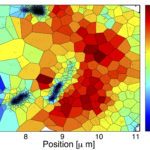Link to Pubmed [PMID] – 24411239
Biophys. J. 2014 Jan;106(1):74-83
Protein mobility is conventionally analyzed in terms of an effective diffusion. Yet, this description often fails to properly distinguish and evaluate the physical parameters (such as the membrane friction) and the biochemical interactions governing the motion. Here, we present a method combining high-density single-molecule imaging and statistical inference to separately map the diffusion and energy landscapes of membrane proteins across the cell surface at ~100 nm resolution (with acquisition of a few minutes). Upon applying these analytical tools to glycine neurotransmitter receptors at inhibitory synapses, we find that gephyrin scaffolds act as shallow energy traps (~3 kBT) for glycine neurotransmitter receptors, with a depth modulated by the biochemical properties of the receptor-gephyrin interaction loop. In turn, the inferred maps can be used to simulate the dynamics of proteins in the membrane, from the level of individual receptors to that of the population, and thereby, to model the stochastic fluctuations of physiological parameters (such as the number of receptors at synapses). Overall, our approach provides a powerful and comprehensive framework with which to analyze biochemical interactions in living cells and to decipher the multiscale dynamics of biomolecules in complex cellular environments.

